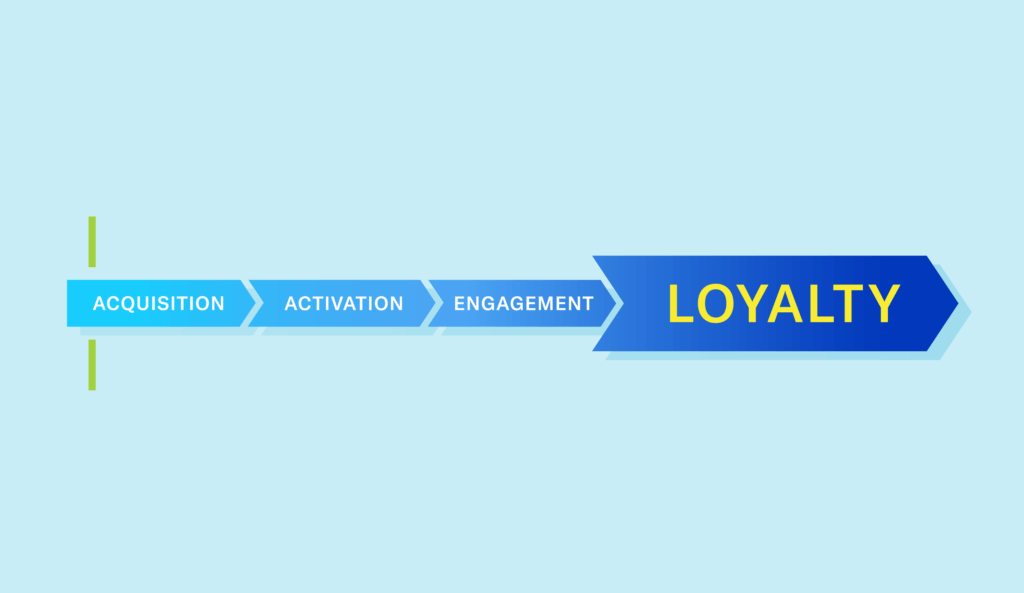Drive Loyalty By Mastering the Mobile App Lifecycle

Deidre Wright PR Director, Airship

Share to my network
In this article
Categories
Book a meeting
Connect with our team of experts to discuss your conversion and loyalty goals, and how we can help you achieve them faster.
Book a meetingMobile apps have become the center of digital experiences. That’s where customers browse content, make purchases, share feedback, refer their friends and perform many other high-value actions. However, too often, brands treat their apps as just another messaging channel, driving customers to install but failing to account for activation and engagement when experiences matter most. While app downloads and first conversion are essential, they only matter if customers convert repeatedly.
“When acquisition costs are high, customer lifespans need a long enough runway to amortize those costs and generate returns. In other words, brands must hold on to newly acquired customers for dear life,”
(Forrester Research, Inc., “Unlock Your Revenue Growth Potential,” June 4, 2023).
To move people beyond Activation to Engagement, brands must show customers they know them. Our research found that people prefer personalization based on their past behaviors, purchases, and interests/preferences they share with brands. However, there’s a fine line between personalized experiences and invasive ones. For example, predictive suggestions based on “everything a brand knows about you” may cross that line: it was the least preferred type of personalization. Mastering this nuance will allow you to optimize experiences for each individual across the app lifecycle.
Additionally, as third-party data dwindles, brands are shifting focus to collect zero-party data – information that people proactively share with brands – for a more future-proof understanding of their customers. In-app experiences, such as surveys, preference centers or even clicks on notification buttons, are a goldmine for collecting zero-party data. Brands creating these mutually beneficial exchanges throughout the mobile app lifecycle will get more value from their app investments.
Here, we share proven strategies for optimizing each stage of the mobile app lifecycle to help you gather valuable customer insights and drive long-term loyalty.
Acquisition: The Starting Point
The mobile app lifecycle begins with Acquisition, where you first capture peoples’ attention and encourage them to download your app. This stage often draws a sizable portion of brands’ budgets and lays the foundation for everything that follows, so creating an experience that drives positive ROI is critical.
App Store Optimization (ASO) — Optimizing app distribution inside the app stores should be a priority at this stage. ASO is the top driver of app acquisition and is crucial for market success. According to Apple, 70% of App Store visitors use search to discover apps, and almost 65% of downloads happen directly after a search. Additionally, “searching and browsing the app stores” continues to be the top way every generation globally discovers new apps to download, according to our survey of 11,000 global consumers.
High-quality visuals and compelling descriptions optimized with target keywords and positive reviews all play a vital role in boosting download rates. However, effective ASO doesn’t stop there. For the same reasons retailers need to merchandise their store displays, brands must continuously experiment and optimize store listings for peak performance. A commitment to testing and data-driven decisions is imperative for ongoing success with customer acquisition.
Activation: First Impressions Matter
The next step is Activation, which is all about turning downloads into active users. The first few moments a user spends with your app are the most crucial and can define whether or not they convert into a loyal customer. In fact, only 7% on average return to an app on the 30th day after they first open it.
A streamlined onboarding process can make all the difference in helping customers understand your app’s value without overwhelming them. Early interactions should highlight the app’s key features and give users a clear sense of the benefits they stand to gain from regular usage. Testing optimal timing, triggers and orchestration will help you better understand what moves your customers toward engagement and retention, insights you can incorporate into future experiences.
It’s tempting to start collecting data immediately, but it’s important to be thoughtful about it. Ask for only the most essential information upfront to avoid creating friction. The priority requests to make during Activation are opt-in permissions and customer interests; in addition, gaining registration/authentication will allow you to recognize customers across other channels and unify their customer experience. Prioritizing this information from the get-go will set you up for success in the Engagement and Loyalty phases.
Engagement: Keep Customers Coming Back
As customers become familiar with your app, you should shift your focus to Engagement. This is where the real work begins, as customers can only transition from Activation to Engagement after building a habit of interaction. Keeping them engaged requires a mix of strategies and depends on your app’s category. For example, a customer may read the news daily, but order from a quick-serve restaurant bi-monthly. The goal is to reiterate and remind them of the unique value your app delivers, such as fast service, special access, personalized interactions, unique products and affordability.
In-app messaging is a powerful tool for communicating your app’s unique value, offering a direct line to customers for tips, updates or exclusive offers. Personalized push notifications tailored to individual user behavior can also significantly increase interaction rates and nudge customers to return to the app. Gamification elements like rewards or challenges create a fun, enjoyable experience that increases the amount of time customers spend within your app. Employing any one of these strategies – or all of them – will help boost customer engagement and pave the way for sustained use.
Loyalty: Cultivating Long-Term Relationships
The mobile app lifecycle culminates in the Loyalty phase, where you turn mobile app customers into brand advocates. Loyalty is the end goal of every interaction a customer has with your brand and starts as early as the Acquisition phase. It’s more than just repeat usage — it’s about creating a deep connection with your customers during moments of attention.
Implementing loyalty strategies that reward continued engagement, such as exclusive content or features to loyal customers, adds an extra layer of value. By regularly updating the app based on customer feedback, you can improve functionality and demonstrate a commitment to providing ongoing convenience and improved experiences.
Loyalty done right pays dividends. Brands that excel in building app loyalty increase revenues 2.5X faster than industry peers and are expected to deliver up to 5X shareholder returns over the next 10 years.
Mastering the Mobile App Lifecycle with Airship
Successfully navigating the mobile app lifecycle is no small feat, but with the right strategies, you’ll increase engagement, gain loyalty, capture customer value and ultimately drive positive ROI.
Airship’s Activation and Engagement benchmark reports offer a deep dive into what success looks like across app store categories. They’ll help you understand how your performance stacks up against the competition’s.
Looking to go deeper on personalization or your zero-party data strategy? Our Strategic Services team can help you develop better end-to-end mobile app experiences for your customers and brand. Or check out the following resources:
Articles
- Are You Maximizing Your Downloads With ASO?
- 4 Ways to Master App Store Optimization
- The First 30 Days: 3 Strategies For Capturing Customer Attention
- First Impressions: Optimizing the Activation Phase
- Turn Clicks into Customer Connections with 5 Valuable App Engagement Practices
- 3 Strategies for Increasing Customer Engagement
- 3 Ways to Create Customer Loyalty
- Unlocking Loyalty through Mobile App Experiences: Mobile Leaders Forum Berlin
- Assess Your Mobile Maturity to Drive Greater Impact
On-Demand Webinars
- The New Era of ASO: Conquering the Modern App Stores
- Capture Customer Attention: 3 Strategies in 30 Days
- Clicks to Connections: 5 Engagement Practices Your App Customers Will Value
- 45 Ways to Boost App Engagement & Retention
- 7 Ways Mobile Can Accelerate Loyalty Program Growth
- The Way to Master Mobile App Experiences
Benchmarks & eBooks